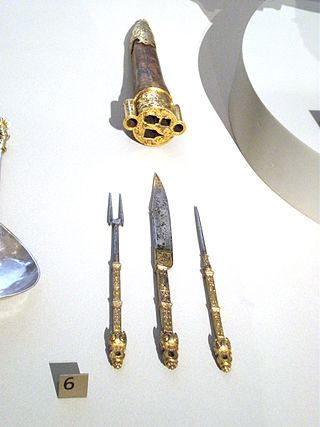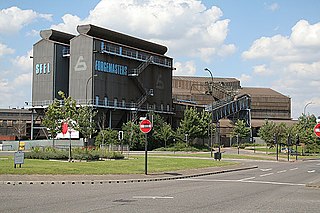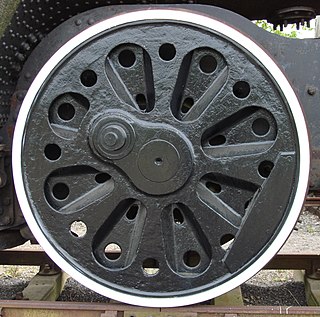
Vickers was a British engineering company that existed from 1828 until 1999. It was formed in Sheffield as a steel foundry by Edward Vickers and his father-in-law, and soon became famous for casting church bells. The company went public in 1867, acquired more businesses, and began branching out into military hardware and shipbuilding.

Cutlery, includes any hand implement used in preparing, serving, and especially eating food in Western culture. A person who makes or sells cutlery is called a cutler. The city of Sheffield in England has been famous for the production of cutlery since the 17th century and a train – the Master Cutler – running from Sheffield to London was named after the industry. Bringing affordable cutlery to the masses, stainless steel was developed in Sheffield in the early 20th century.
Outokumpu Oyj is a group of international companies headquartered in Helsinki, Finland, employing 10,600 employees in more than 30 countries. Outokumpu is the largest producer of stainless steel in Europe and the second largest producer in the Americas. Outokumpu also has a long history as a mining company, and still mines chromium ore in Keminmaa for use as ferrochrome in stainless steel. The largest shareholder of Outokumpu is the Government of Finland, with 26.6% ownership, including the shares controlled by Solidium, The Social Insurance Institution of Finland, Finnish State Pension Fund and Municipality Pension Agency.

Martensitic stainless steel is a type of stainless steel alloy that has a martensite crystal structure. It can be hardened and tempered through aging and heat treatment. The other main types of stainless steel are austenitic, ferritic, duplex, and precipitation hardened.

Sir John Brown, English industrialist, was born in Sheffield. He was known as the Father of the South Yorkshire Iron Trade.

Harry Brearley was an English metallurgist, credited with the invention of "rustless steel". Based in Sheffield, his invention brought affordable cutlery to the masses, and saw an expansion of the city's traditional cutlery trade.

John Brown and Company of Clydebank was a Scottish marine engineering and shipbuilding firm. It built many notable and world-famous ships including RMS Lusitania, RMS Aquitania, HMS Hood, HMS Repulse, RMS Queen Mary, RMS Queen Elizabeth and Queen Elizabeth 2.

Sheffield Forgemasters is a heavy engineering firm located in Sheffield, South Yorkshire, England. The company specialises in the production of large bespoke steel castings and forgings, as well as standard rolls, ingots and bars. The company was nationalised in July 2021, becoming wholly owned by the UK's Ministry of Defence.

In 2008, Sheffield ranked among the top 10 UK cities as a business location and aims to regenerate itself as a modern technology and sports based city. Sheffield has an international reputation for metallurgy and steel-making. It was this industry that established it as one of England's main industrial cities during the 18th, 19th and 20th centuries. This industry used Sheffield's unique combination of local Iron, Coal and water power supplied by the local rivers. This fuelled a massive growth in the city's population that expanded from 60,995 in 1801 to a peak of 577,050 in 1951. However, due to increasing competition from imports, it has seen a decline in heavy engineering industries since the 1960s, which has forced the sector to streamline its operations and lay off the majority of the local employment. The steel industry now concentrates on more specialist steel-making and, in 2005, produced more steel per year by value than at any other time in its history. The industry is now less noticeable as it has become highly automated and employs far fewer staff than in the past. However a small number of skilled industrial automation engineers still thrive in it. Today the economy is worth over £7 billion a year.
Samuel Osborn and Company was a steelmaker and engineering tool manufacturer situated in Sheffield, South Yorkshire.

The Northern General Hospital is a large teaching hospital and Major Trauma Centre in Sheffield, England. Its departments include Accident and Emergency for adults, with children being treated at the Sheffield Children's Hospital on Western Bank. The hospital is managed by the Sheffield Teaching Hospitals NHS Foundation Trust.
Viners is a United Kingdom brand of cutlery, kitchenware and dinnerware products, founded in 1901 in Sheffield, England by Adolphe Viener and his sons. By the 1960s, it had expanded to subsidiaries in Ireland, Australia and France. In mid-2000, Oneida, of the United States, paid $25 million in cash for Viners which was put into administration on 30 October 2014. Merseyside-based Rayware, a privately owned housewares group, bought Viners out of administration for £1.6 million in November 2014 and in 2015 set about "reinvigorating the brand".
Jessop Saville and Company, the Sheffield-based special steel makers, was founded in 1929 following a merger of J.J.Saville and Co., Limited and William Jessop and Company, both of these being long established in the trade and in the city.
Dr William Herbert Hatfield FRS was an English metallurgist who contributed to the development of stainless steel.

Taylor's Eye Witness Works is an industrial building on Milton Street in the Devonshire Quarter area of Sheffield city centre, South Yorkshire, England. The works are a Grade II listed building which since their foundation in 1852 have always specialised in producing kitchen and pocket knives along with various associated products. The building is believed to be the only traditional works in Sheffield which still manufactures its original products. It stands next to the Beehive Works another listed cutlery works on Milton Street.

Butchers Wheel or Butcher Works is a former cutlery and tool factory in Sheffield, South Yorkshire. The last of the manufacturing tenants left in 2004. The building is a listed historic site, and is now used for residential and retail purposes.

Portland Works is a former cutlery works in the Highfield area of Sheffield in England. Built in 1877, it is now a Grade II* listed building and one of the last remaining working examples of a purpose built metal trades factory. In early 2013, it was bought by nearly five hundred people, through one of the country's largest community share issues. Today Portland Works operates a collection of workspaces for traditional and modern craftspeople and is home to more than 30 small businesses.

The Bulleid Firth Brown wheel (BFB) was a locomotive wheel developed for the Southern Railway in the late 1930s. It was a disc wheel, in contrast to the usual spoked wheels in general use on British railways. The wheel was designed by Oliver Bulleid and developed by the steel company Firth Brown of Sheffield.
Crucible Industries, commonly known as Crucible, is an American company which develops and manufactures specialty steels, and is the sole producer of a line of sintered steels known as Crucible Particle Metallurgy (CPM) steels. The company produces high speed, stainless and tool steels for the automotive, cutlery, aerospace, and machine tool industries.














